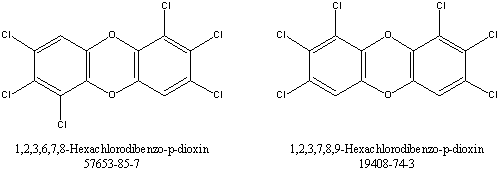
NTP Study Reports

NTP Study Reports
Home » Study Results & Research Projects » NTP Study Reports » All Long-Term Reports » Abstract for TR-202 - Hexachlorodibenzo-p-Dioxins

| Chemical Formula: C12H2Cl6O2 | - | 3D Structure* |
|---|---|---|
| *To view structure, download free Chemscape Chime Plug-in | ||
Hexachlorodibenzo-p-dioxin (HCDD) is formed as a byproduct during the manufacture of certain chlorophenols and has been found in trichlorophenol, tetrachlorophenol, pentachlorophenol and in the chlorophenol-derived herbicides 2,4-dichlorophenoxyacetic acid (2,4-D) and 2,4,5-trichlorophenoxyacetic acid (2,4,5-T). From 1967 to 1970, the concentration of HCDD in commercial pentachlorophenol ranged from 0.03 to 38 ppm. Since then, HCDD levels in pentachlorophenol have been reduced to less than 1 ppm.
A bioassay of a mixture of 1,2,3,6,7,8-and 1,2,3,7,8,9-hexachlorodibenzo-p-dioxins (HCDD) for possible carcinogenicity was conducted by dermal application of a suspension of this substance to Swiss-Webster mice.
HCDD (0.01 µg) suspended in 0.1 ml acetone was applied to the backs of 30 mice of each sex 3 days per week for 104 weeks. During the first 16 weeks, doses were 0.005 µg HCDD per application. An additional 30 mice of each sex were pretreated with one application of 50 µg DMBA in 0.1 ml acetone 1 week before the initiation of the HCDD applications. As vehicle controls, 45 mice of each sex received 0.1 ml of acetone three times per week. Thirty animals of each sex served as untreated controls. Mean body weights of all test and vehicle control mice were comparable throughout the bioassay; mean body weights of untreated controls were higher than those of the test and vehicle-control groups.
In male mice, the incidence of alveolar/bronchiolar carcinomas in the group administered only HCDD was significantly higher (P=0.045) than that in the vehicle-control group; however, the incidence was not significantly higher when compared with untreated controls.
In female mice, the incidences of fibrosarcomas of the skin were significantly higher (P=0.044) in animals administered HCDD (both with and without pretreatment with DBMA) than in the untreated-control group; however, when the incidences were compared with those of the vehicle controls (relative risk=3.037) the results were not significant.
Under the conditions of this bioassay, HCDD was not carcinogenic for male or female Swiss-Webster mice.
Levels of Evidence of Carcinogenicity: | ||
| Male Mice: | Negative | |
| Female Mice: | Negative | |
Synonym: HCDD
Note: Hexachlorodibenzo-p-dioxin and 1,2,3,7,8,9-hexachlorodibenzo-p-dioxin were previously tested in Swiss-Webster mice administered dermally (See TR-198, reported 1980).
Report Date: August 1980
Target Organs & Incidences from 2-year Studies
You may link to the full technical report in pdf format ( Note: A print ready copy of the document is presented in Portable Document Format (pdf) which requires the Acrobat Reader plug-in -- download a free copy of the reader.)
Web page last updated on October 14, 2004
The National Institute of Environmental Health Sciences is one of the National Institutes of Health within the U.S. Department of Health and Human Services. The National Toxicology Program is headquartered on the NIEHS campus in Research Triangle Park, NC.